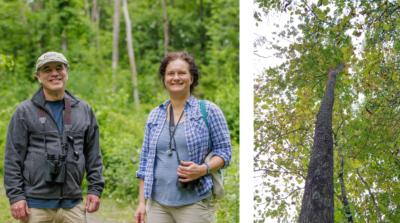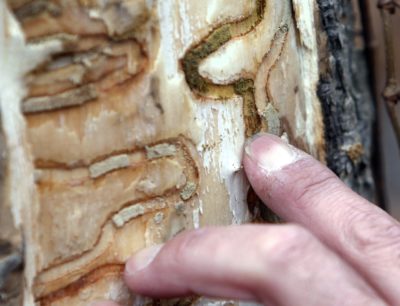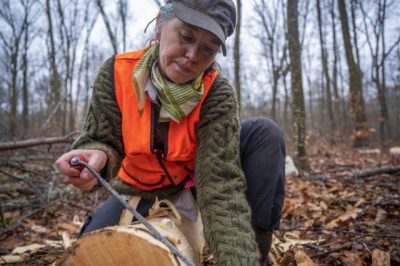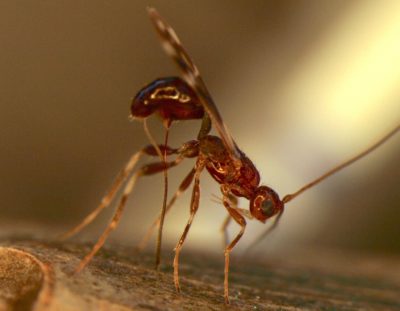The tree Radka Wildova and Jonathan Rosenthal wished to point me was just some hundred ft from the trail at Tivoli Bays, a state wildlife administration house in Rhinebeck, New York. Nonetheless attending to it required bushwhacking through a thicket of non-native honeysuckle, multiflora rose, and poison ivy. “It’s like a museum of invasives proper right here,” Rosenthal, an ecologist based totally in shut by New Paltz, seen as we stumbled through the underbrush.
The tree, as quickly as reached, was maybe 100 ft extreme and ten inches in diameter. It was sporting a metal tag that acknowledged it as amount 047. “This generally is a inexperienced ash,” Wildova, a botanist who’s moreover based totally in New Paltz (and is Rosenthal’s partner) launched. Ash bushes are dioecious, which suggests they produce each all male or all female flowers.
“I really feel it’s a she,“ Wildova acknowledged. “Nonetheless they don’t flower yearly, so it might be onerous to tell.”
What was distinctive about tree amount 047 was that it was not merely alive, nonetheless healthful. Since emerald ash borer beetles have been first launched to the US, most probably throughout the Nineteen Nineties, tons of of hundreds and hundreds of bushes have died. Throughout the Hudson Valley, the overwhelming majority of ash have succumbed.
In some unspecified time in the future, scientists hope, borer-resistant bushes will current seeds to trade among the many hundreds and hundreds of ash which have been misplaced.
Nonetheless a very small proportion of ash bushes — maybe 1 p.c — look like resisting the beetles. These have turn into commonly known as “lingering ashes,” and Wildova and Rosenthal routinely brave poison ivy for them.
The two run a program often called Monitoring and Managing Ash, which matches by the acronym MaMA. (“Our tagline is ‘Come to MaMA,’” Rosenthal joked to me.) This method trains state and native officers and residents learn the way to find out lingering ashes and likewise collects samples from resistant bushes.
Over the winter, Wildova recounted, she had clambered out to amount 047 carrying a pruning seen hooked as much as a protracted pole. With the seen, she had decrease a small division from the tree. “It is vital to do it when the bushes are dormant,” she outlined.
The division had been despatched out to be grafted onto ash root stock to develop a model new little one tree, which had then been despatched to a greenhouse at Cornell Faculty. When the tree is old enough to offer flowers — female ones, presumably — it’s going to be crossed with one different lingering ash to offer bushes that, it is hoped, will in all probability be far more resistant to emerald ash borers than its dad and mother. In some unspecified time in the future — so the hope extra goes — these resistant bushes will current seeds to trade among the many hundreds and hundreds of ash which have been misplaced. A similar effort has been underway for numerous years on the U.S. Division of Agriculture’s evaluation station in Delaware, Ohio. Among the many bushes in Ohio are literally being field-tested. (Since ash bushes are regionally tailor-made, it acquired’t be enough to develop one variety of E.A.B.-resistant ash; many sorts will in all probability be needed.)

Left: Researchers Jonathan Rosenthal and Radka Wildova. Correct: “Lingering ash” amount 047 in Tivoli Bays wildlife administration house in New York.
Radka Wildova; Jerry Monkman / EcoPhotography
“There are 5 ranges of grief, and one among them is resignation, which it appears to be like like an infinite number of people are at,” Rosenthal acknowledged. “Of us will say, ‘These bushes are disappearing,’ and they also’ll write them off. So we’ve found that one of many easiest methods to work together with them and get them actually to do one factor, is to permit them to know that there is hope and there are points which may be achieved.”
Emerald ash borers, or E.A.B.’s as they’re normally often called, are about half an inch prolonged with shimmering inexperienced wings. The beetles, which can be native to China, Korea, and japanese Russia, seemingly have been launched to the U.S. through contaminated supply crates or wooden pallets. They’ve been first detected in Michigan in 2002 and by now have unfold all by way of the Midwest, New England, the Mid-Atlantic states, and much of the Southeast. In 2022, the first inhabitants was detected on the West Coast, in Oregon.
Ash are an vital a part of Japanese forests; in places like north-central Vermont, they make up higher than 1 / 4 of the tree cowl. The bushes’ seeds are an obligatory meals provide for birds and small mammals, and their leaves decompose additional shortly than these of bushes like oak, in order that they’re key to nutrient recycling. Dozens of insect species rely upon ash, and tons of are associated to ash bushes. If these bushes are misplaced, creatures that depend upon them could very correctly be pushed to extinction.
In accordance with a present paper, the emerald ash borer is “in all probability essentially the most dangerous and expensive invasive forest insect” North America has seen.
“There is not a rescue island,” is how David Wagner, a professor of ecology and evolutionary biology on the Faculty of Connecticut, has put it. In accordance with a present paper by researchers on the U.S. Navy Corps of Engineers, E.A.B. is “in all probability essentially the most dangerous and expensive invasive forest insect” North America has seen.
Ash, within the meantime, shouldn’t be just one tree, nonetheless a whole group of them. (Curiously enough, no one is conscious of exactly what variety of species of ash there are in North America; estimates run from 15 to 25.) Most species look like inclined to E.A.B., along with inexperienced ash, white ash, and black ash, each of which is vital for numerous causes, ecological and cultural.
Inexperienced ash are fast-growing and pollution-tolerant. Due to this, they’ve been normally planted in metropolis settings after Dutch elm sickness swept through. (It’s been estimated that eradicating and altering metropolis ash bushes could end up costing cities higher than $12 billion.) White ash is probably going one of many few native bushes species that’s in a position to rising up through the thicket of non-native vegetation that now sorts the understory in numerous Japanese forests. So with out them, additional forests would possibly turn into “museums of invasives.” For a lot of of baseball historic previous, bats have been product of white ash. (Now wood bats are primarily comprised of maple.)

Tunnels carved by emerald ash borer larvae beneath the bark of an ash tree.
Mike Groll / AP Image
Black ash reside in swamps and play a key perform of their habitat’s hydrology; when the ash die, the swamps would possibly flip to open water. Black ash may also be central to many Indigenous cultures; its wood has explicit properties that make it prized by basket-makers. In accordance with one among their creation tales, the Wabanaki people, whose territory as quickly as included numerous New England and southeastern Canada, emerged from an arrow shot proper right into a black ash tree.
For all these causes, E.A.B. would by itself rely as an ecological disaster. Nonetheless in its assault on Japanese forests, it has a great deal of agency. American chestnut bushes have been type of worn out in throughout the first half of the 20th century by chestnut blight, a fungal pathogen launched from Asia. (Contaminated bushes have been first noticed on the Bronx Zoo in 1904.) Dutch elm sickness, one different fungal pathogen, killed off numerous the U.S.’s elm bushes throughout the middle part of the ultimate century. (Whatever the title, Dutch elm sickness most probably moreover obtained right here from Asia.) Japanese hemlocks are literally at risk from woolly adelgid, bugs launched from Japan, whereas beech bushes are threatened by beech bark sickness, attributable to an insect, and likewise by beech leaf sickness, attributable to a nematode.
“These bushes are being pulled correct out of the forest by these forest pests and pathogens,” Leigh Greenwood, director of The Nature Conservancy’s Forest Pest and Pathogen Program, acknowledged. “In some places, you get native tree regrowth that offers comparatively good compensation, though you’re nonetheless missing the biodiversity. Nonetheless some other place, you don’t get good compensation, after which your entire ecology begins to interrupt down on itself.”
Invasive pests do correctly because of they’ve left their predators behind. One methodology to fight them is to import their pests to pester them.
Simply currently, The Nature Conservancy launched a model new initiative, “Timber in Peril,” aimed towards accelerating efforts to breed resistant ash, elms, hemlocks, and beeches. Among the many many groups which have acquired funding from the initiative, which is supported by a $4.7 million grant from the New York-based Manton Foundation, are MaMA and the ash breeding program at Cornell. The problem could even finance masters, PhD, and postdoctoral positions for specialists who can stick with it the breeding problem, which, it’s anticipated, will take a very long time.
“That’s generational work for the folks along with the bushes,” she acknowledged.
Invasive pests normally do correctly because of they’ve left their predators behind. One methodology to fight them — a method often called biocontrol — is to import their pests to pester them. On a separate monitor, scientists are working to help ash by spreading bugs that kill E.A.B.
On a improbable day not method again, I joined Claire Rutledge, an entomologist with the Connecticut Agricultural Experiment Station, to look at the outcomes of some of those efforts. We met up at a farm in Kent, Connecticut. Rutledge had marked the ash bushes she wished to look at with orange tape.

Entomologist Claire Rutledge cuts bark from an ash tree within the hunt for emerald ash borer larvae.
Tyler Russell / Connecticut Public
As rapidly because the hazards of E.A.B. have been acknowledged, researchers with the U.S. Division of Agriculture went looking out for the beetles’ pure enemies. They found three of them in northeast China — all parasitic wasps. Certainly one of many wasps didn’t do correctly throughout the chilly, so the researchers went to Russia to find a hardier species. Many biocontrol efforts have gone awry, so the wasps underwent rigorous testing to make sure they did not moreover assault native bugs. On the conclusion of this testing, the E.A.B. predators have been launched at tons of of websites throughout the Midwest and the Northeast, along with numerous in western Connecticut. Many of the introductions have been worthwhile enough that the wasps have multiplied and unfold. (The wasps nonetheless could set off harm the researchers did not anticipate; sadly, that could be very troublesome to look at and, as quickly because the wasps have established themselves, far more troublesome to do one thing about.)
On the farm in Kent, Rutledge was checking to make sure the populations had survived the winter and have been reproducing. The taped bushes have been all nonetheless alive, though not for prolonged. An assistant of Rutledge’s decrease down one with a chainsaw; it was about 40 ft extreme and maybe six inches in diameter. Rutledge began slicing away at its bark with a two-handled drawknife. “This generally is a pretty contaminated tree,” she acknowledged.

A parasitic wasp, Spathius galinae, probes ash bark for emerald ash borer larvae.
Jian Duan / USDA
Female emerald ash borers lay their eggs on the bark of ash bushes. When these hatch, the larvae bore through the bark and start consuming the vascular tissue beneath. As they eat their methodology alongside, the larvae sort tunnels that run up the facet of the tree in a set of switchback-like curves. An ash might probably survive a few of these tunnels, nonetheless enough of them disrupts the transfer of nutritional vitamins and the tree dies. Rutledge was excited to find a clutch of wasp cocoons in one in all many tunnels she sliced through. “Cool,” she acknowledged.
The cocoons, from the species Spathius galinae, appeared like tiny grains of rice. Rutledge outlined that the wasps’ mother had deposited her eggs inside an E.A.B. larva. When these eggs had hatched, the wasp larvae had then eaten their methodology through the beetle larva, killing it. That they’d now pupated, and, had they been left alone, would have emerged as grownup wasps.
Further slicing yielded a E.A.B. larva in its third instar, which suggests it had molted twice. At this stage, the larva was most probably protected against predation. “This generally is a third and it seems fully fully happy, sadly,” Rutledge acknowledged.
When beetle numbers are extreme, the launched wasps are not any match for E.A.B. The hope is that as mature ash bushes die and beetle numbers decline, the launched wasps will maintain the E.A.B. inhabitants low enough that even non-resistant saplings shall be able to survive. Rising a mature ash is a sluggish course of, though, so it’s going to be a very long time sooner than it’s clear whether or not or not this hope will in all probability be realized.
Throughout the meantime, sadly, additional threats to Japanese forests are sure to emerge. Just a few years prior to now, a model new imported pest, the elm zigzag sawfly, was detected in Virginia; it’s now in a minimal of 4 additional states: Maryland, Pennsylvania, North Carolina, and New York. Because the website Entomology For the time being put it in a put up on the sawfly: “Proper right here We Go As soon as extra.”
